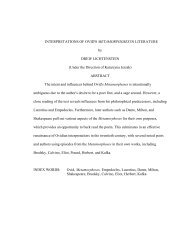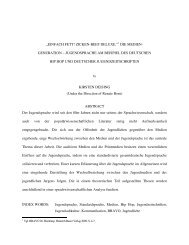RED BOAT TROUPES AND CANTONESE ... - University of Georgia
RED BOAT TROUPES AND CANTONESE ... - University of Georgia
RED BOAT TROUPES AND CANTONESE ... - University of Georgia
You also want an ePaper? Increase the reach of your titles
YUMPU automatically turns print PDFs into web optimized ePapers that Google loves.
performing industry when I was young. I remember round wooden trays about 2 feet in diameter<br />
with two long pieces <strong>of</strong> wood to station and align wood pieces together. Each tray had a hole in<br />
the middle for stacking the trays together in the crowded boat when they are not in use. The tray<br />
was used to carry dishes and bowls <strong>of</strong> rice. Usually one tray with two dishes was served to a<br />
party <strong>of</strong> six apprentices, musicians or performers. The trays were placed on the floor instead <strong>of</strong><br />
on the ji coeng (boxes for costumes) so that the food did not make the costumes dirty. People eat<br />
while squatting on the ground; it is not elegant for other people to see, but the practice lasted<br />
until the 1960s.<br />
The food was usually not much to distribute among 6 people. Besides the good quality rice,<br />
usually two dishes and one salty dish were served. The salty dish enhances the flavour <strong>of</strong> rice so<br />
that the young and active performers could stay full if food were not enough for these people.<br />
Rice was ample, and is usually in good quality because those lead performers who could afford<br />
to pay the cooks to make extra food usually wanted good rice for the meal.<br />
Ling: I heard from Mr. Wong Toa that singers in the earlier days sang at higher register.<br />
Yuen: After moving to indoor performance, performing at higher pitches to be heard better was<br />
no longer necessary. Singers are singing 2 to 3 semi-tones lower. With the availability <strong>of</strong><br />
microphones, performers now sing with the assistance <strong>of</strong> the device. Performers no longer need<br />
to strive to practice volume as it used to be.<br />
Ling: Do you know when harm seu gor 132 songs become popular?<br />
Yuen: Probably after the Republic <strong>of</strong> China was established [1911]. Before that time, opera<br />
performances were oi gong ban [Non-Pearl Troupes].<br />
Ling: What were some common traditional plays you learned as an apprentice?<br />
Yuen: Plays like San Tung Huang Ma and Ping Gua Bi Yiu. At the time <strong>of</strong> being an apprentice, I<br />
hardly think other than what si fu taught—just learned whatever was trained.<br />
Ling: I admire your effort in arranging teaching material and preservation <strong>of</strong> the art, and I knew<br />
that you and Dr. Sau Y. Chan had spent tremendous time to design teaching material for Hong<br />
Kong schools.<br />
Yuen: I had discussed with Dr. Chan that performance and research should come hand in hand.<br />
Ling: Do you think that there were both female and male performers on Red Boats?<br />
Yuen: I think there were just male performers, we will have to verify that. 133 Male performers<br />
did the dan (female role).<br />
132<br />
Narrative songs <strong>of</strong> the fisherman, the Dan Gaa. The boats were their permanent homes.<br />
133<br />
I called Mr. Wong Toa after the interview, he confirmed Mr.Yuen’s statement that there were just men on the allmale<br />
troupes.<br />
60






